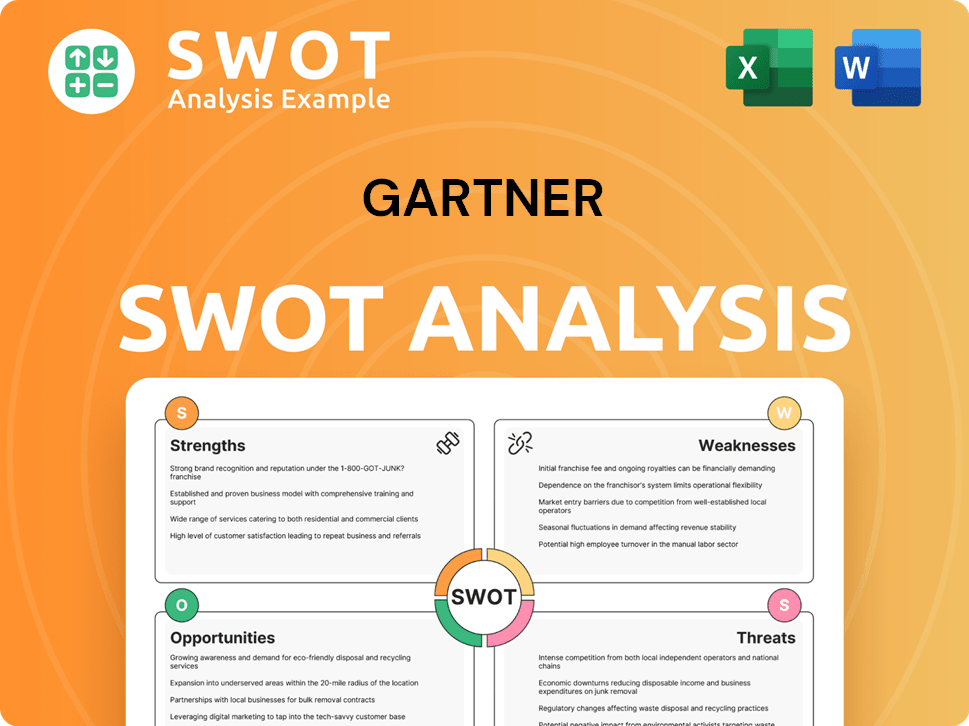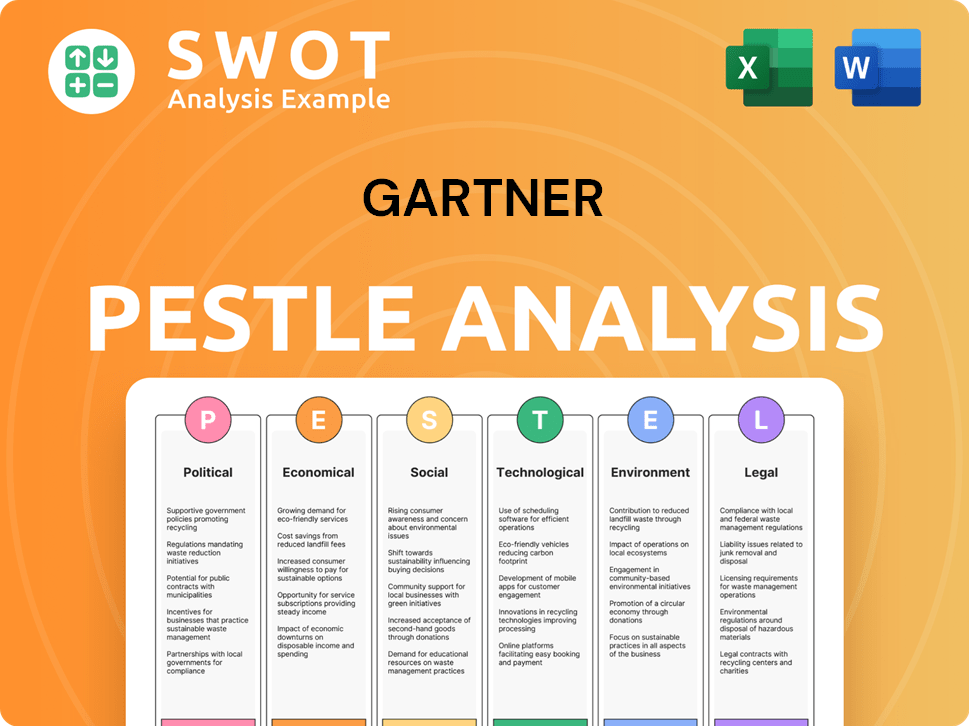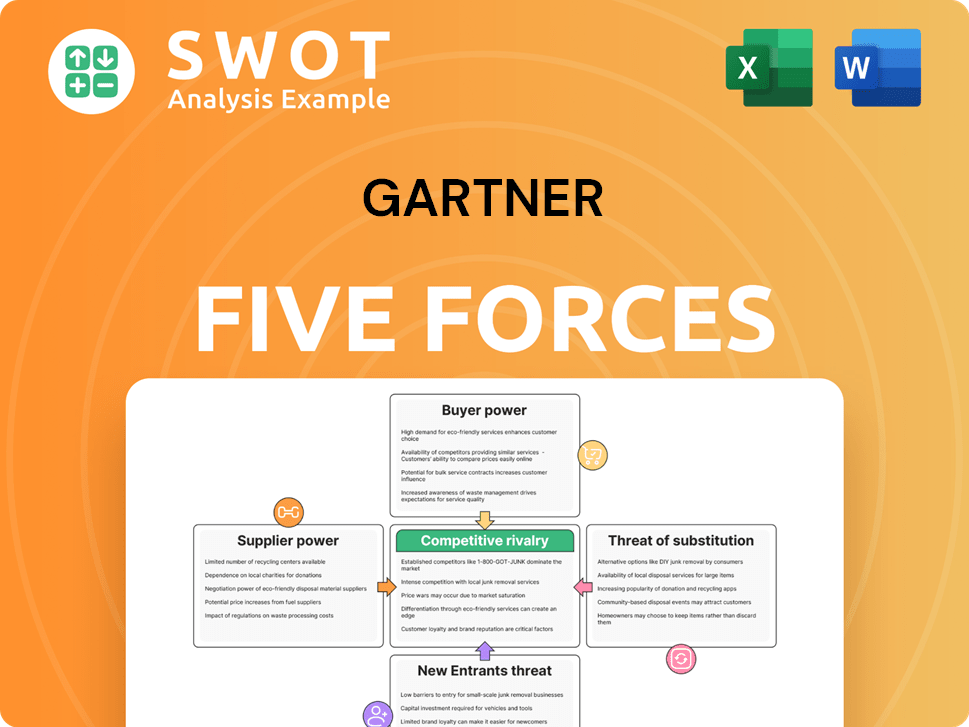Gartner Bundle
How Does Gartner Dominate the Market?
Gartner, a global powerhouse in research and advisory services, relies on a sophisticated sales and marketing strategy to maintain its industry leadership. Its success hinges on delivering objective, actionable insights to executives across various sectors, driving significant market influence. This approach fuels its product offerings, including research, executive programs, and consulting, solidifying its formidable presence.

Gartner's Gartner SWOT Analysis is a testament to its strategic prowess. Founded in 1979, Gartner has evolved its Gartner sales strategy and Gartner marketing strategy to navigate a complex digital landscape, achieving impressive financial results, with total revenues reaching $6.3 billion in fiscal year 2024. This comprehensive exploration will dissect the firm's approach to delivering products, its diverse marketing tactics, and the key campaigns driving its continued growth, providing a deep dive into its Gartner business strategy.
How Does Gartner Reach Its Customers?
The sales channels employed by the company are primarily centered around direct sales teams. These teams engage directly with a diverse clientele, including large corporations, government entities, tech firms, and investment houses. This approach supports the company's various business segments, such as research, conferences, and consulting.
The company's sales strategy involves a multi-faceted approach. In 2024, the Global Technology Sales Contract Value (GTS CV) reached $4.0 billion, marking a 7% year-over-year increase. The Global Business Sales Contract Value (GBS CV) also saw growth, increasing by 12% year-over-year to $1.2 billion, demonstrating the effectiveness of their sales strategies across different business functions.
The evolution of the company's sales channels is significantly influenced by the shift towards digital interactions in the B2B landscape. The company predicts that by 2025, 80% of B2B sales interactions will occur in digital channels. This strategic move necessitates a strong emphasis on digital adoption and omnichannel integration. The company's insights highlight the importance of enhancing sales teams' digital skills.
The core of the company's sales strategy involves direct sales teams. These teams are crucial for engaging with a diverse client base, including large corporations, government agencies, and technology companies.
Digital channels are becoming increasingly important. The company is leveraging online portals as self-service sales channels. This includes ensuring seamless integration with back-end systems to provide a unified customer experience.
The company focuses on omnichannel integration to provide a consistent customer experience. This approach ensures that customers have a seamless experience whether they interact online or offline.
Enhancing sales teams' digital skill sets is a key focus. The company is building future-forward sales technology roadmaps to facilitate complex buying decisions. This is crucial in an increasingly digital environment.
The company's sales strategy is multifaceted, focusing on direct sales and digital channels. The company's approach includes direct sales teams, digital adoption, and omnichannel integration. These strategies are crucial for driving revenue and maintaining a strong market position. For more insights, see the Target Market of Gartner.
- Direct Sales: Direct engagement with clients.
- Digital Transformation: Leveraging online portals.
- Omnichannel Experience: Unified customer experience.
- Digital Skills: Enhancing sales team capabilities.
Gartner SWOT Analysis
- Complete SWOT Breakdown
- Fully Customizable
- Editable in Excel & Word
- Professional Formatting
- Investor-Ready Format

What Marketing Tactics Does Gartner Use?
The marketing tactics employed by Gartner are multifaceted, integrating both digital and traditional methods to boost brand awareness, generate leads, and drive sales for its research, executive programs, and consulting services. This approach is crucial in a market where understanding the Revenue Streams & Business Model of Gartner is key to effective strategy.
In 2024, the marketing landscape saw significant shifts, with digital channels accounting for a substantial portion of marketing spend. Gartner's strategies reflect these trends, emphasizing data-driven insights and customer-centric approaches to maintain a competitive edge in the industry. The company's focus on personalization and advanced technologies underscores its commitment to evolving marketing practices.
Gartner's marketing strategy is heavily influenced by data and customer insights, using sophisticated techniques to segment its audience and personalize its marketing efforts. The company leverages technology platforms and analytical tools to enhance customer experience and optimize marketing campaigns. This data-driven approach is essential for understanding the Gartner market analysis and adapting to the dynamic needs of its clients.
Digital channels are a cornerstone of Gartner's marketing strategy, with a significant allocation of resources towards online platforms. Paid online channels lead the digital mix, representing a major area of investment.
Gartner prioritizes paid media investments, with search, social advertising, and digital display advertising as top channels for allocation. This targeted approach helps in reaching specific customer segments effectively.
While digital marketing is prominent, Gartner also incorporates offline channels such as event marketing, sponsorships, and television. These channels provide additional avenues for brand visibility and engagement.
Gartner uses data-driven marketing, customer segmentation, and personalization. This approach helps in tailoring marketing efforts to the specific needs and preferences of its diverse customer base.
AI is emerging as a critical tool, with 73% of marketers piloting or using generative AI. Gartner uses technology platforms and analytics tools, including Customer Data Platforms (CDPs) and Content Marketing Platforms (CMPs).
Investment in marketing technology (martech) to improve personalization is a core strategy, with CMOs prioritizing personalization allocating 25.4% of their budget to martech. This investment supports the company's focus on delivering personalized experiences.
Gartner's marketing tactics are designed to build awareness, generate leads, and drive sales. The company focuses on several key areas to achieve these goals.
- Digital Marketing: Utilizing online channels, including search, social media, and display advertising.
- Data Analytics: Leveraging customer journey analytics and AI to enhance customer experience.
- Personalization: Employing advanced technologies like CDPs and CMPs to tailor content and experiences.
- Content Marketing: Creating consistent and engaging content to maintain brand voice and scale communication.
- Event Marketing: Participating in industry events to increase brand visibility and generate leads.
Gartner PESTLE Analysis
- Covers All 6 PESTLE Categories
- No Research Needed – Save Hours of Work
- Built by Experts, Trusted by Consultants
- Instant Download, Ready to Use
- 100% Editable, Fully Customizable

How Is Gartner Positioned in the Market?
Gartner's brand positioning centers on being a trusted advisor that delivers actionable insights to leaders across various business functions. The company distinguishes itself through independent research and analysis, offering data-driven guidance instead of product-specific recommendations. This approach is crucial in the competitive landscape of industry research, helping shape the Gartner business strategy.
The core message of Gartner revolves around empowering executives and their teams to make better decisions to address their mission-critical priorities. This focus on value, innovation, and expertise is designed to appeal to its target audience of C-suite executives and business leaders. The company's reputation is reinforced by its widely recognized research reports, such as the Magic Quadrants and Hype Cycles, which serve as industry benchmarks.
Gartner's consistent brand messaging across all channels reinforces its credibility and reliability, which is essential for its success. Understanding the Owners & Shareholders of Gartner is also important for understanding the company's long-term strategic goals. The company continually adapts its research focus and methodologies to stay relevant and ahead of market trends, particularly in emerging areas like AI, ensuring its Gartner market analysis remains cutting-edge.
Gartner's brand is built on providing objective, data-driven advice. This independence from specific product recommendations sets it apart in the industry. This is a key element of their Gartner marketing strategy.
The primary target audience is C-suite executives and business leaders. Gartner tailors its messaging to resonate with their needs for strategic advantage and informed decision-making. This helps with Gartner sales strategy.
Consistency across all channels is vital for reinforcing credibility. This includes research reports, digital content, and client interactions. Consistent branding can increase revenue by up to 23%.
Gartner adapts its research to reflect market trends. Continuous adaptation is essential to remain relevant, especially in the face of competitive threats. This includes analyzing the Gartner competitive landscape.
Gartner's brand is built on several key elements that contribute to its strong market position. These elements work together to create a cohesive brand identity that resonates with its target audience and supports its Gartner sales and marketing alignment.
- Independent Research: Providing unbiased, data-driven insights.
- Actionable Guidance: Offering practical recommendations for business leaders.
- Industry Benchmarks: Establishing standards through reports like Magic Quadrants.
- Strategic Advantage: Helping clients make informed decisions to gain a competitive edge.
Gartner Business Model Canvas
- Complete 9-Block Business Model Canvas
- Effortlessly Communicate Your Business Strategy
- Investor-Ready BMC Format
- 100% Editable and Customizable
- Clear and Structured Layout

What Are Gartner’s Most Notable Campaigns?
The sales and marketing strategies of Gartner are characterized by ongoing initiatives, particularly given its subscription-based model. Rather than relying on short-term campaigns, the company focuses on sustained efforts to drive engagement and showcase its research and insights. A key element of its strategy involves leveraging major events and recurring publications to maintain a strong presence in the market.
Gartner's approach emphasizes consistent messaging and thought leadership. This is particularly evident in its focus on digital transformation and the use of AI in business. The continuous release of influential reports, such as the 'Magic Quadrant' and 'Hype Cycle,' also plays a crucial role in establishing the company's authority and driving demand for its detailed research. These reports are integral to Gartner's marketing strategy.
These strategies aim to build brand visibility and credibility within the industry. While specific sales figures for these initiatives are not publicly disclosed, their widespread adoption and industry references suggest significant success. Gartner's strategies are designed to support its position as a go-to source for technology evaluation and market analysis.
Gartner's annual IT Symposium/Xpo events are crucial for client engagement and showcasing the latest research. These global events offer direct interaction, learning, and networking opportunities for clients and prospects. They serve as a major touchpoint, driving sales and reinforcing the company's brand.
Gartner consistently highlights the transformative power of digital and AI in business. A key campaign centers around the prediction that by 2025, the majority of B2B sales interactions will occur in digital channels. This is supported by reports and webinars designed to guide organizations in building adaptive sales models.
The continuous release of the 'Magic Quadrant' and 'Hype Cycle' reports is a powerful marketing tool. These publications generate industry discourse, establish Gartner's authority, and drive demand for its detailed research. The reports directly influence marketing strategies across industries. For example, the 2024 Hype Cycle for Digital Marketing highlights trends like generative AI and digital twins of the customer.
Gartner's reports, such as the Magic Quadrant for Customer Data Platforms (2024), showcase leading technology providers. This indirectly benefits Gartner by solidifying its position as a go-to source for technology evaluation and market analysis. These reports highlight key trends to inform business decisions.
Gartner's campaigns, although ongoing, are designed to enhance brand visibility and credibility. These efforts support its market share analysis and competitive intelligence services. The company's approach focuses on delivering valuable insights and establishing thought leadership.
- Gartner's research reports are essential for sales and marketing alignment.
- The company's go-to-market strategy leverages a combination of events and publications.
- Customer acquisition strategies are driven by the continuous release of key reports.
- Gartner's marketing technology stack supports its content marketing approach.
Gartner Porter's Five Forces Analysis
- Covers All 5 Competitive Forces in Detail
- Structured for Consultants, Students, and Founders
- 100% Editable in Microsoft Word & Excel
- Instant Digital Download – Use Immediately
- Compatible with Mac & PC – Fully Unlocked

Related Blogs
- What are Mission Vision & Core Values of Gartner Company?
- What is Competitive Landscape of Gartner Company?
- What is Growth Strategy and Future Prospects of Gartner Company?
- How Does Gartner Company Work?
- What is Brief History of Gartner Company?
- Who Owns Gartner Company?
- What is Customer Demographics and Target Market of Gartner Company?
Disclaimer
All information, articles, and product details provided on this website are for general informational and educational purposes only. We do not claim any ownership over, nor do we intend to infringe upon, any trademarks, copyrights, logos, brand names, or other intellectual property mentioned or depicted on this site. Such intellectual property remains the property of its respective owners, and any references here are made solely for identification or informational purposes, without implying any affiliation, endorsement, or partnership.
We make no representations or warranties, express or implied, regarding the accuracy, completeness, or suitability of any content or products presented. Nothing on this website should be construed as legal, tax, investment, financial, medical, or other professional advice. In addition, no part of this site—including articles or product references—constitutes a solicitation, recommendation, endorsement, advertisement, or offer to buy or sell any securities, franchises, or other financial instruments, particularly in jurisdictions where such activity would be unlawful.
All content is of a general nature and may not address the specific circumstances of any individual or entity. It is not a substitute for professional advice or services. Any actions you take based on the information provided here are strictly at your own risk. You accept full responsibility for any decisions or outcomes arising from your use of this website and agree to release us from any liability in connection with your use of, or reliance upon, the content or products found herein.